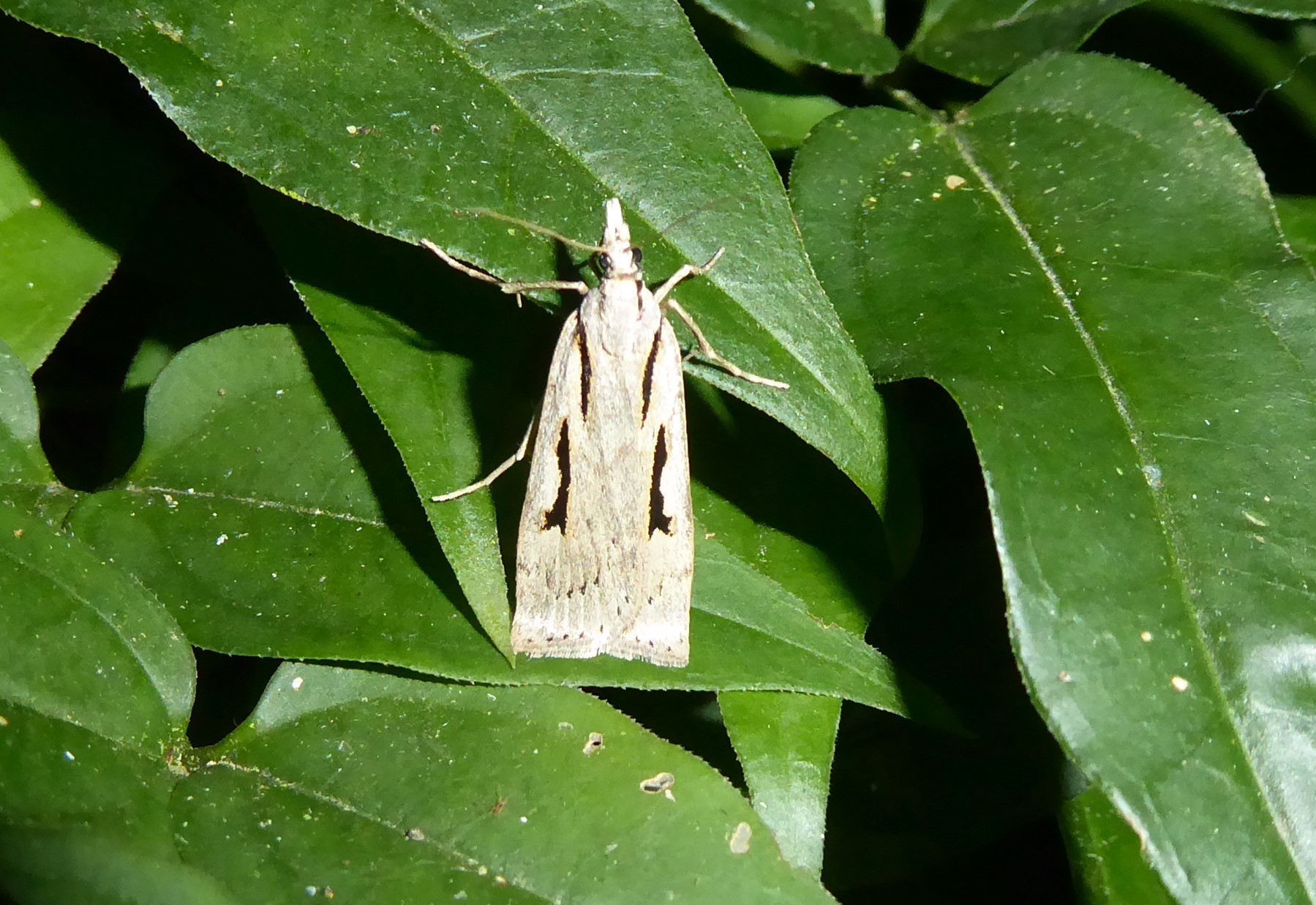Scoparia Rotuella on:
[Wikipedia]
[Google]
[Amazon]
''Scoparia rotuella'' is a species of moth in the family Crambidae. It was first described by

 The wingspan is 28–29 mm. The forewings are light greyish ochreous, irrorated (speckled) with white beneath the costa. There is a black median streak from the base of the costa to the disc, margined with clear yellowish ochreous. The first line has the form of a sharply defined black streak, margined with clear yellowish ochreous. The second line is represented by a row of black dots and there is a terminal row of black dots. The hindwings are very pale ochreous grey.
The wingspan is 28–29 mm. The forewings are light greyish ochreous, irrorated (speckled) with white beneath the costa. There is a black median streak from the base of the costa to the disc, margined with clear yellowish ochreous. The first line has the form of a sharply defined black streak, margined with clear yellowish ochreous. The second line is represented by a row of black dots and there is a terminal row of black dots. The hindwings are very pale ochreous grey.
Cajetan Felder
Baron Cajetan von Felder (german: link=no, Cajetan Freiherr von Felder; 19 September 1814 – 30 November 1894) was an Austrian lawyer, entomologist and liberal politician. He served as mayor of Vienna from 1868 to 1878.
Life and career
Felder ...
, Rudolf Felder
Rudolf Felder (2 May 1842 in Vienna – 29 March 1871 in Vienna) was an Austrian jurist and entomologist. He was mainly interested in Lepidoptera, amassing, with his father, Cajetan Felder, a huge collection.
Works
*with Cajetan Felder, Lepidopte ...
and Alois Friedrich Rogenhofer
Alois Friedrich Rogenhofer (22 December 1831, in Vienna – 15 January 1897, in Vienna) was an Austrian entomologist. He was a curator at the Naturhistorisches Museum in Vienna, where he was the first keeper of the Lepidoptera. Rogenhofer was main ...
in 1875. It is endemic to New Zealand and, although considered localised, is found throughout the country. As at 2022 the life history of this species is largely unknown, but it has been hypothesised that this species may have two broods a year. Adults are on the wing all year round and are attracted to light.
Taxonomy
It was described byCajetan Felder
Baron Cajetan von Felder (german: link=no, Cajetan Freiherr von Felder; 19 September 1814 – 30 November 1894) was an Austrian lawyer, entomologist and liberal politician. He served as mayor of Vienna from 1868 to 1878.
Life and career
Felder ...
, Rudolf Felder
Rudolf Felder (2 May 1842 in Vienna – 29 March 1871 in Vienna) was an Austrian jurist and entomologist. He was mainly interested in Lepidoptera, amassing, with his father, Cajetan Felder, a huge collection.
Works
*with Cajetan Felder, Lepidopte ...
and Alois Friedrich Rogenhofer
Alois Friedrich Rogenhofer (22 December 1831, in Vienna – 15 January 1897, in Vienna) was an Austrian entomologist. He was a curator at the Naturhistorisches Museum in Vienna, where he was the first keeper of the Lepidoptera. Rogenhofer was main ...
in 1875 under the name ''Crambus rotuellus''. In 1885 Edward Meyrick placed this species in the genus ''Xeroscopa'' and amended the epithet to ''rotuella''. In 1913 Meyrick again revised the taxonomy of the species and placed it within the genus '' Scopaira''. George Hudson discussed and illustrated this species under the name ''Scoparia rotuella'' in his 1928 book ''The butterflies and moths of New Zealand''. The male lectotype, collected in Nelson by T. R. Oxley, is held at the Natural History Museum, London.
Description

 The wingspan is 28–29 mm. The forewings are light greyish ochreous, irrorated (speckled) with white beneath the costa. There is a black median streak from the base of the costa to the disc, margined with clear yellowish ochreous. The first line has the form of a sharply defined black streak, margined with clear yellowish ochreous. The second line is represented by a row of black dots and there is a terminal row of black dots. The hindwings are very pale ochreous grey.
The wingspan is 28–29 mm. The forewings are light greyish ochreous, irrorated (speckled) with white beneath the costa. There is a black median streak from the base of the costa to the disc, margined with clear yellowish ochreous. The first line has the form of a sharply defined black streak, margined with clear yellowish ochreous. The second line is represented by a row of black dots and there is a terminal row of black dots. The hindwings are very pale ochreous grey.
Distribution
''S. rotuella'' is endemic to New Zealand. This species has been observed in the North, South and Stewart Islands as well as on Campbell Island and Chatham Island. It is regarded as being localised, that is restricted to certain localities within those islands. This species has been observed at altitudes ranging from sea-level to elevations of about 1,200 m.Behaviour
The life history of this species is largely unknown. However it has been hypothesised that there are two broods in a year. The adults of this species are attracted to light and have been collected all year round. Adults of this species have been shown to pollinate '' Helichrysum selago'' and '' Veronica salicifolia''.Threats
Specimens of this species have been tested for '' Wolbachia'' infection and one was found to be positive for the bacteria. ''Wolbachia'' bacteria are common in reproductive organs of insects and the presence of this bacteria can result in the species suffering from a sex ratio bias in favour if female moths. The lack of male moths can result in a population decline of a species.References
{{Taxonbar, from=Q15640108 Moths described in 1875 Moths of New Zealand Scorparia Endemic fauna of New Zealand Taxa named by Alois Friedrich Rogenhofer Endemic moths of New Zealand Taxa named by Cajetan von Felder